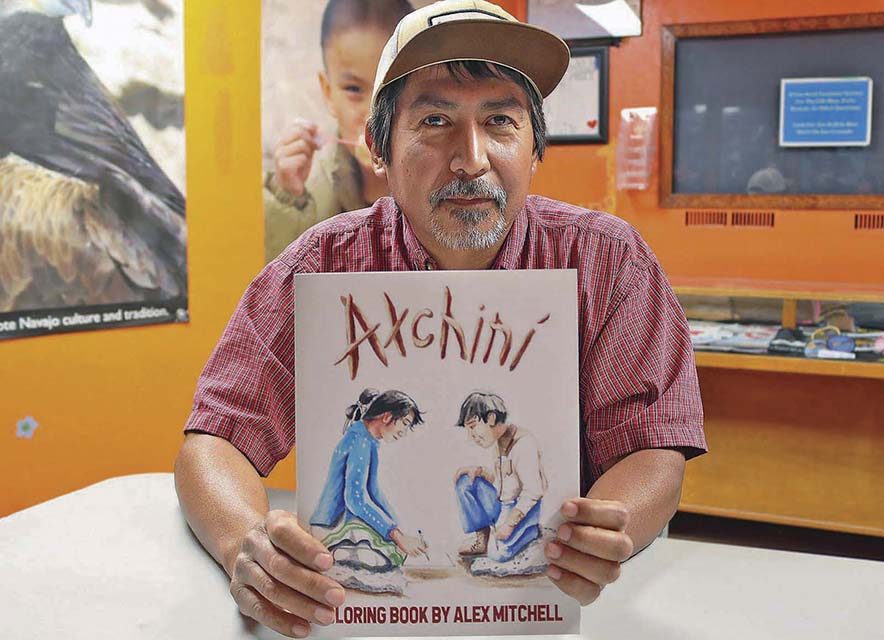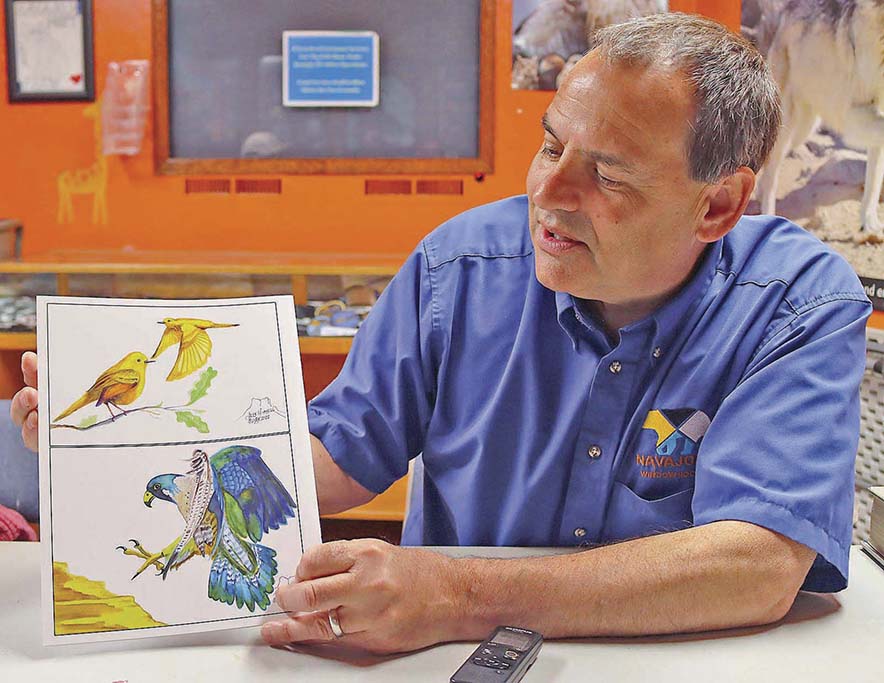
‘Ałchiní’: Navajo Nation Zoo brings its first coloring book

Navajo Times | Boderra Joe
Watercolorist Alex Mitchell, from Tsaile Peak, Ariz., holds up his coloring book “Ałchiní” on June 19 at the Navajo Nation Zoo in Window Rock. The coloring book Mitchell created in association with the Navajo Nation Zoo, where hand-drawn animals throughout the zoo are featured in the book.
WINDOW ROCK – A coloring book filled with images from the local Navajo Nation Zoo is not something one sees often, said David Mikesic, the Navajo Nation Zoo manager and zoologist.
The zoo staff had long harbored a dream of creating their own original coloring book, and now, for the first time ever, “Ałchiní” is available for purchase. This unique effort was brought to life through a collaboration between the zoo and the talented Diné watercolorist, Alex Mitchell from Tsaile Peak, Arizona.
According to Mikesic, the zoo is the only tribally owned zoo in the country, and for the past 14 years, he has been with the zoo. A coloring book of a kind would be a grand memory for visitors to take home, color, and learn from. It would be a special treat after their visit, he said.

Navajo Times | Boderra Joe
Navajo Nation Zoo Manager and Zoologist David Mikesic holds a copy of the “Ałchiní” coloring book. He talks about his admiration of Alex Mitchell’s watercolor of birds featured on the back cover on June 19 at the zoo in Window Rock.
“It’s not something that is typical, but I thought for the Navajo Nation Zoo, being a sanctuary for injured and orphaned animals, I thought a coloring book that kids could bring home and play with (would be) a nice memory for their visit here,” Mikesic said on June 19 at the zoo. This coloring book is not just a fun activity, but also a valuable educational tool, allowing children to learn about the diverse wildlife housed in the zoo.
Mikesic searched for an artist and hoped that an artist would arrive when the time was right.
“You can always download images from the internet and make your own coloring book, but I thought that’s not what we’re about,” he continued. “We’re about making things articulate to the Navajo Nation.”
Knowing that the zoo is owned and operated by the Navajo Nation, Mikesic believed it was about being unique and highlighting the animals homed in the zoo was what the coloring book would represent.
Seeking an artist
Several years ago, an artist arrived.
David Mikesic noticed Alex Mitchell’s work when he walked into the Navajo Nation Zoo with a book complete with watercolor paintings that he had done.
“What really drew me to his (Mitchell) artwork was the colors…he also really likes to put motion and activity into it,” Mikesic said with a smile. “I felt like he would translate that motion and activity from his watercolor images into a coloring book.”
Mikesic said Mitchell’s watercolor paintings of birds reminded him of the work by John James Audubon, a French American artist and naturalist in the 1800s who made high-quality images of all the bird species in the U.S.
“As you can tell, there’s activity, there’s flight, there’s color,” Mikesic described Audubon’s work. “I was like, ‘Oh my god! It’s the John James Audubon of the Navajo world,” he said about Mitchell’s work when he was first introduced to his work.
After viewing Mitchell’s work, Mikesic knew he would be the artist to create a high-quality coloring book for the Navajo Nation.
With motion generating, Mikesic and Mitchell created a partnership. Draft after draft was discussed and reviewed in creating this coloring book, which may appear to be simple.
Four or so months ago, Mitchell brought in the final drafts of the 20 images of animals that are housed in the zoo. Everything from mą’ii and mą’iitsoh to shash and many more was ready to be colored.
Mikesic added that each of the images had a motion to them. “We really hope youngsters will really enjoy picking up the coloring book and coloring the pages and enjoying the images.”
The zoo published roughly 1,000 copies, half of which are available for purchase at the zoo or from the artist himself.
More recently, Mitchell created a vibrant collection of 30 watercolors of local birds that were the impetus of this book; two of these are found on the back cover: a peregrine falcon and yellow warbler.
Remembering relatives
Born in Ganado, Arizona, and residing in Tsaile, Ariz., Alex Mitchell began his art journey when he picked up his first crayon in 1977. He recalls drawing with pencils on ‘Chief’ sketch paper from early childhood.
In the early 1980s, Mitchell’s interest in hot-rodding cars and heavy-metal music inspired his early artworks.
“Art has always been within the family,” said Mitchell, who is Bit’ahnii, born for Yé’ii Dine’é Táchii’nii. His maternal grandfather is Deeshchii’nii, and his paternal grandfather is ‘Áshįįhí.
He described it as silversmithing; it was used in his family for trades for food or livestock. It is what most artists resorted to by trading and has grown since.
Stories passed down to him by his late father, Mike Mitchell, have been passed down through generations. This allowed Alex to grow fond of local wildlife in the Navajo Nation and the stories behind them that his father shared.
He found himself combining animals and local landscapes as an authentic art style, which he depicts in watercolor. He describes the basis of watercolor and how it came from his late uncle Stanley Mitchell, a silversmith and watercolor artist who inspired him.
Alex finds himself mesmerized by watercolors and how each color corresponds with another. This is almost how a silversmith crafts silver into pieces of worn jewelry or any other displays to tell a story.
“That is how the two came together,” Alex said regarding storytelling and watercolor. He added that he grew up in a traditional home where his relatives were medicine people and stories were told daily.
He is aware that there are animals and stories he could not reproduce because of traditional beliefs and teachings.
Additionally, he researched and asked many Diné Bizaad teachers for precise spelling for animals in Diné Bizaad.
“It’s not an easy task,” Alex said. “It was a challenging thing.”
He even thought about how the words are displayed and written, which he said comes back to the natural landscape by drawing the words using the idea of wood being put together.
“It goes back to natural resources,” he added. “Through these stories, there’s teachings as well,” he said. “Art has always been within the family.”
He approached the book with the intent for it to be simple and easily retained by the minds of all ages.
“This is something to have a good awareness of what’s out there instead of looking off to the TV or internet…something that was out there to bring it back here,” Alex said.








 Highway 264,
Highway 264, I-40, WB @ Winslow
I-40, WB @ Winslow